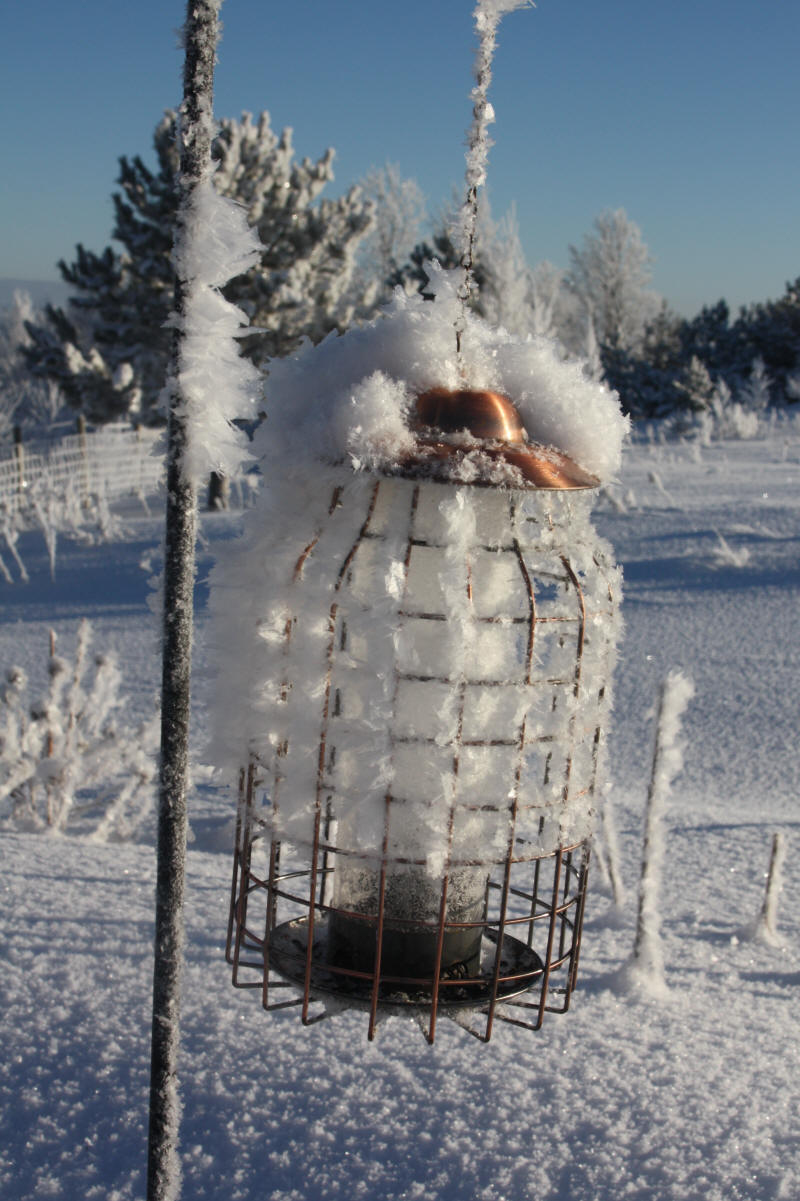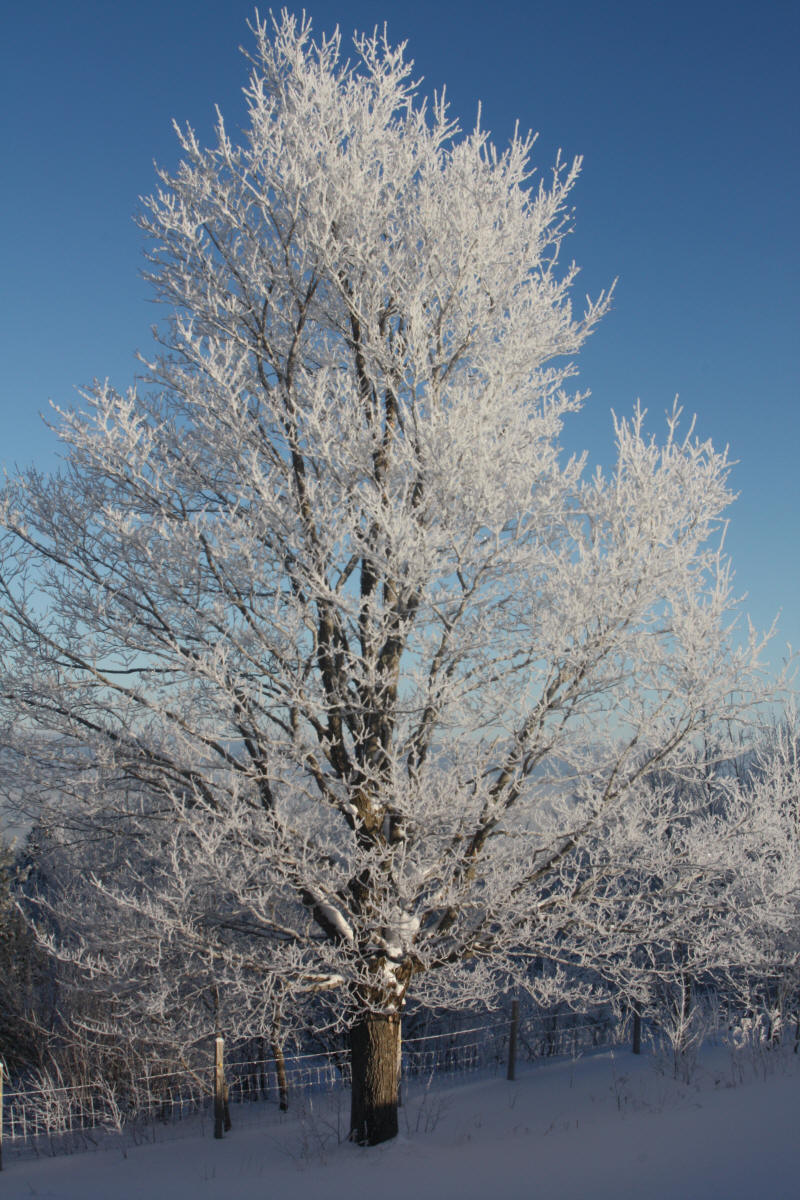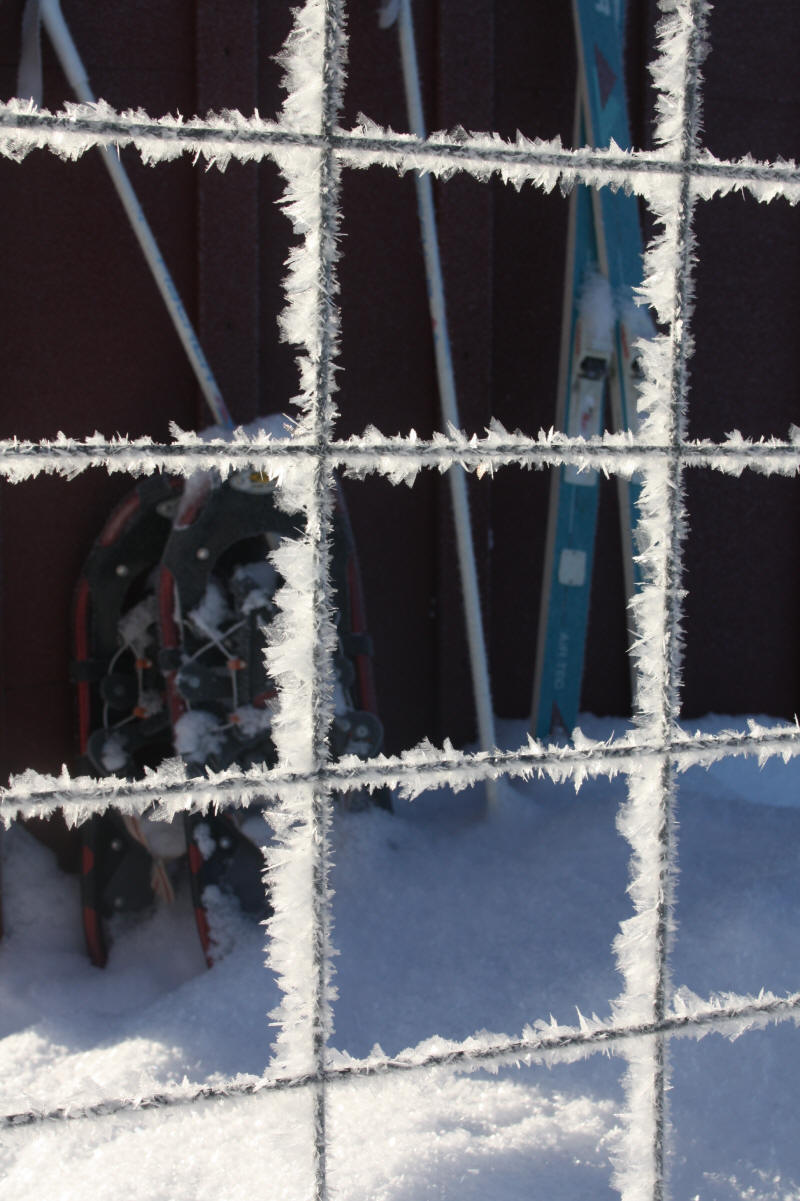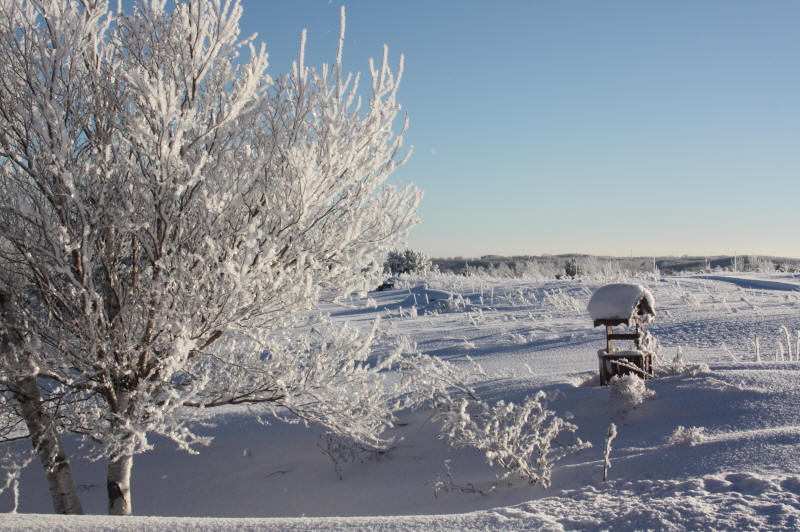|
by Melanie B. Fullman, US Forest Service
The other morning, we awoke to a wondrous sight:
half-inch hoar frost that clung to everything – tree branches, bird
feeders, last summer’s grass stalks, the door to the wood shed – and
SPARKLED in the early morning sun. It was amazing!
So what IS
Hoar Frost?
If you recall that most compounds can be found in 3
forms – as a gas, a liquid, and a solid – you might also remember
that if you cool a gas, you get a liquid, and if you keep cooling
the liquid, you get a solid. In the case of water, that solid is
ice. Hoar frost is a result of the direct conversion of water vapor
(a gas) to ice crystals without going through the liquid phase.
The temperature at which air is totally saturated is called the dew
point. When water vapor condenses into liquid, the result is
raindrops and dew. If water vapor condenses directly into ice, we
get snowflakes and frost. If the dew point is above freezing, dew
forms. But if the air is sufficiently dry that the dew point is
below 32°F, the water vapor converts directly into ice, creating
hoar frost.
Hoar frost is very different from frozen dew. Frozen
dew is dew that has frozen after it was formed. So frozen dew looks
like frozen water droplets, whereas hoar frost is a delicate icy
structure.

Furry Ice
Hoar frost is basically an intricate
build-up of interlocking ice crystals – a white, 'furry' form of
ice. These crystals come in a huge variety of shape – needles, cups,
plates, fern, and feather – depending on the temperature at which
they developed. The size of the crystals depends on the time,
temperature, and amount of water vapor available.
Hoar frost
also has different names, depending on where it forms. Surface hoar
are crystals that grow on snow, ice, or already frozen surfaces. Air
hoar is a deposit of hoar frost on objects above the surface, such
as tree branches, plant stems, wire, etc. Depth hoar refers to cup
shaped crystals formed in dry snow, beneath the surface.
The
spectacular hoar frost we experienced last week was mostly air hoar.
Air hoar forms on tree branches, plant stems, leaf edges, wires,
poles, etc. The longer the conditions that favor hoar frost, the
longer the crystals. You’ll need to look quickly though: air hoar
tends to be the least durable of the frosts, susceptible to light
winds and the slightest bit of sunshine. As soon as the crystals or
the air around them warms up, evaporation from the crystal surfaces
dissolve them away.
Beautiful, Dangerous? Crystals
The most
common form of hoarfrost is surface hoar. This consists of ice
crystals that form overnight on top of snow. The sparkles we often
see on a clear morning here in the North Woods are the reflections
off the facets of surface hoar crystals. This type of frost occurs
when our snow is warmed during the day, then cooled at night. Since
the night air cools the surface of the snow more than the inside,
water evaporates from inside the snow and re-crystallizes on the
surface. By morning, the snow surface is covered with a layer of
sparkling ice crystals.
Given their delicate appearance, it
might surprise you to learn that surface hoar is a common cause of
avalanches. If cold clear nights with light/no winds follow the
formation of surface hoar, the crystals remain intact. Buried by
subsequent snows, the new upper layer is essentially laying on a
very weak layer of ice crystals. The stage is set, then, for a skier
or snowmobiler to trigger an avalanche. The best way to prevent a
tragedy is for backcountry adventurers to dig a quick snow pit and
examine the layers of snow that have been deposited. The surface
hoar crystals, now frozen in place, are still easy to identify.
Turns out, a quick look for beauty can save the day.

Other Forms
of Frost
Rime is a deposit of ice that forms when the water
droplets in freezing fog or mist stick to the outer surfaces of
objects. Unlike hoar frost; rime is created by the water vapor first
condensing to liquid droplets and then freezing on contact with
anything it touches. Not surprisingly, areas prone to heavy fog are
also prone to rime.
“Soft” rime formations look similar to hoar
frost, with white ice needles and scales. Soft rime is similarly
fragile and can be easily shaken off objects. Hard rime is formed
under the same conditions as soft, but with a harsher wind. Hard
rime has an icy solid appearance, sometimes in bizarre, wind-driven
formations.
Window frosts are those lovely, fern-like creations
that we’ve probably all seen on the inside of windows. Window frost
forms when a pane of glass is exposed to below-freezing temperatures
on the outside and moist air on the inside. Water vapor from the air
inside the building condenses as frost on the inside surface of the
window. Window frost often makes elaborate patterns as the crystal
growth is strongly influenced by the window surface. Scratches,
residual soap streaks, etc., can change the way the crystals
accumulate and grow.
Although the result is undoubtedly pretty,
the cause is considerably less attractive. Window frost is
technically an indicator of a poorly insulated window. Window frost
was more common in the past, when most houses had single-pane
windows. Newer, double-pane windows are much better insulated and
thus not so cold. If you have fern frost on your windows, you’re
probably paying a price for them…
The formation of frost
flowers, or "ice flowers," can occur in the late fall or early
winter when the ground is not yet frozen. As freezing sap in the
stem of some plants expands, it causes long, thin cracks to form
along the length of the stem. Water is then drawn through these
cracks and freezes upon contact with the air. As more water is drawn
through the cracks it pushes the thin ice layers further from the
stem, causing a thin "petal" to form. In the case of woody plants
and tree branches, the freezing water is squeezed through the pores
of the plant into long thin strings of ice that look like hair -
i.e. "frost beard".

Clear Moon, Frost Soon
Clear skies
generally help all kinds of frost form. When a night is cloud free,
heat escapes from the earth quicker, because it isn’t being
‘blanketed’ by clouds. This allows temperatures to drop fast enough
to form frost. Beautiful, amazing frost.
Sure, our mornings are
dark and cold. But there’s so much to ‘frost’ than just scraping if
off a windshield - bundle up, take a walk, enjoy.
|




